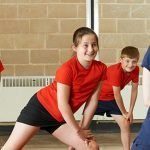Whatever you thought of gym class, the current debate over childhood obesity has made PE more relevant than ever. As the website for First Lady Michelle Obama’s Let’s Move campaign informs us, kids need “60 minutes of active and vigorous play every day to grow up to a healthy weight.” Some schools are even using video games to lure kids to the gym. In an ideal setting, P.E. doesn’t just improve fitness — it also reduces stress, strengthens friendships, and improves self-confidence and self-esteem.
Is your child getting the physical education he needs? Check out our grade-by-grade guidelines to see what kids should be learning in PE.
Basic fitness
PE shouldn’t be all work and no fun. Fourth graders should be able to try out many new sports and games while continuing to learn about the benefits of staying active.
Students should get familiar with the fundamentals of any good workout: warm-ups and cool-downs. PE teachers might introduce new types of stretches, and students should learn how to do sit ups, push-ups, and lunges.
All’s fair in phys ed
Physical education should be about more than just games: Fourth graders should spend time learning about fairness and good sportsmanship too. In the classroom, teachers should emphasize teamwork and cooperation.
Kaiser stresses the importance of having a good attitude: “Sportsmanship is such an important quality. Being able to recognize that everyone has something to contribute to a group or team is a sign of maturity.”
Students should also develop the specific skills needed to succeed on the playing field. That could mean sprinting across a field to catch a Frisbee in a tense match of Ultimate, passing a baton during relay races, or practicing underhand serves while playing beach volleyball.
Fitness tests
In fourth grade, kids might start to be tested on their fitness. School fitness tests often measure aerobic conditioning, muscle strength, and muscle flexibility.
Kaiser notes that working out at home can help things work out better at school: “Encouraging activity at home is a good way to ensure good health. Students should be engaging in 30-60 minutes of active play every day. Even taking a few breaks to work on abdominal strength, shoulder strength, or flexibility will help improve fitness scores.”
Healthy habits
Beyond exercise, children start to understand how to integrate healthy habits into their lives. Students should learn to eat well, sleep enough, and manage stress. Teachers often include lessons about diet and nutrition, lessons that help them sustain the physical skills they learn in PE.
Updated July 2010






